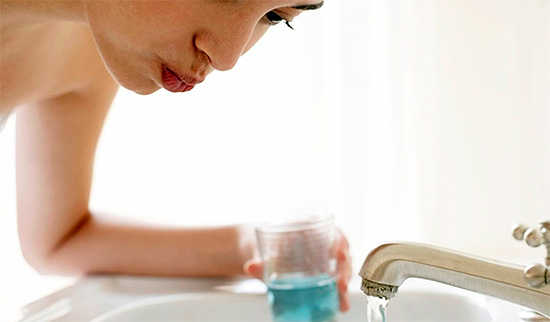
Next you will learn:
- In what cases rinsing the mouth after tooth extraction can do more harm than good;
- The better to rinse your mouth so that the gums heal faster and how to do it right;
- What means should not be used categorically so as not to aggravate the situation;
- Properties of some pharmaceutical and folk remedies suitable for rinsing the mouth after tooth extraction;
As well as a number of other interesting nuances that are important from a practical point of view.
After tooth extraction (extraction), the tormented person often raises the question of how best to rinse his mouth so that the wounded gum heals faster. In this case, the initial situation usually is as follows: after removing the roots from the hole, the dentist puts a sterile gauze swab on the wound and asks to press it down tightly, clenching the jaw, and keep it for 15-20 minutes. Sometimes a doctor may suture a tamponade to minimize the risk of suppuration of the wound (alveolitis).
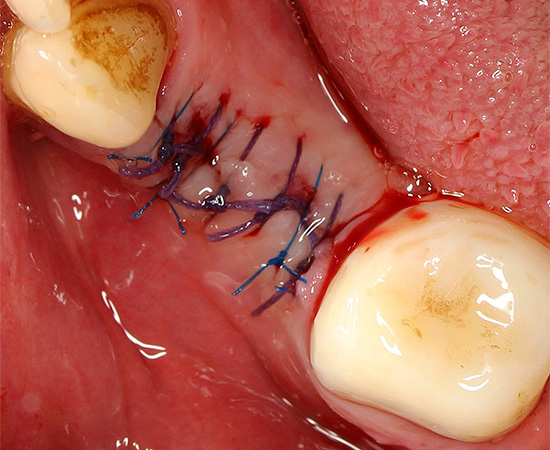
In this condition, a person comes home: there is a lot of blood in his mouth, anesthesia is already departing, the gums are sore, the cheek is starting to swell, or is already swollen. The natural desire in this situation is to rinse your mouth with something disinfectant as soon as possible, in order to disinfect the wound at home and in a calm environment and, if possible, reduce the pain.
However, before deciding what to rinse your mouth after tooth extraction, let's first focus on two main problems that are still the subject of discussion and debate among dental surgeons:
- Does the patient need to rinse his mouth at all after tooth extraction?
- And the second question - are there alternative ways to rinse the healing of the gums?
And are these rinses needed if they can even harm a person
Many researchers on this issue have come to the conclusion that a number of rinse methods prescribed by dentists and practiced in our country are not only not useful, but in some cases very harmful to human health. The main negative point here is the destruction of the blood clot formed after tooth extraction, which is a natural factor in the biological protection of the wound from secondary infection.
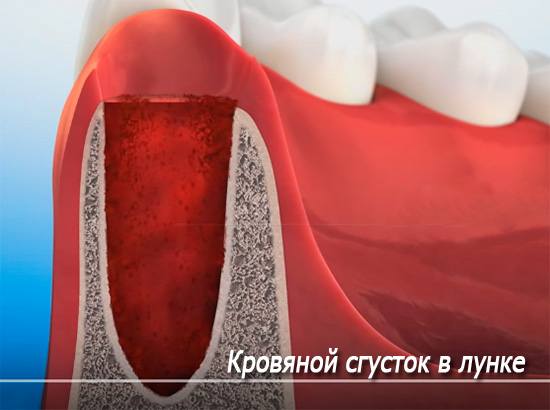
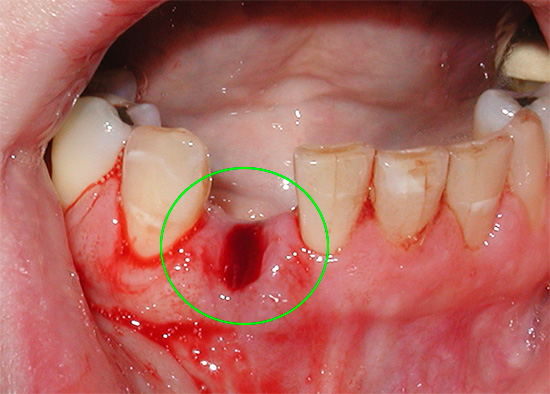
Therefore, today some leading maxillofacial surgeons in the country, practicing tooth extraction and complex maxillofacial operations, initially warned against rinsing the mouth immediately after tooth extraction, believing that after a well-performed surgical procedure in all respects, this procedure will not only speed up the healing of the gums, but vice versa, will create additional risks of suppuration of the wound. But, of course, not everything is so simple, and speaking of rinsing, it is necessary to take into account a number of nuances.
In this case, to whom, why and in what situations are shown mouth rinses after tooth extraction? Is it possible to do without them, and what alternative methods for favorable healing of the gums offers us modern dentistry - let's understand ...
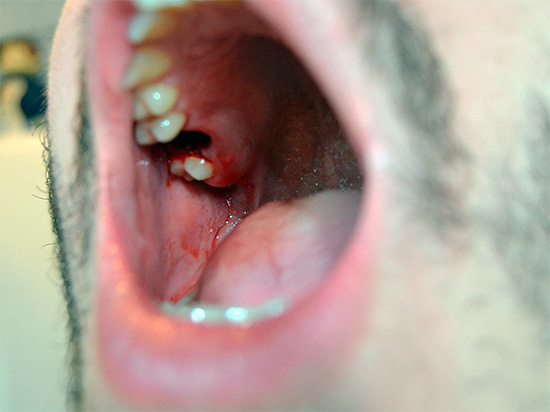
Expert Commentary
“I am a practicing maxillofacial surgeon with 15 years of experience. At that time, when my formation as a specialist was just beginning, there were many different approaches to recommendations for patients after tooth extraction. I actively listened to the advice of familiar experts and prescribed rinsing with soda and decoctions of herbs (chamomile, sage), believing that this would improve the quality of healing of the hole after tooth extraction.
And only much later (about 5 years later) did it become clear to me that the lion's share of all these methods was developed not entirely for “our” people. Due to too hard rinsing almost from the first hours after tooth extraction, many of my patients simply washed a blood clot from the hole, and I had to treat alveolitis almost every week. An empty hole quickly began to become clogged with leftover food and other muck, causing severe suppuration.
So now in my practice I prefer to “ennoble” the hole after tooth extraction in such a way that then no rinses, ointments, baths, lotions and other heresies are prescribed. At the same time, I practically do not have a single alveolitis, not just in a month, but sometimes in a year! In general, my position on mouthwashes is fully covered and, I hope, my colleagues and their patients will come in handy. ”
Dental surgeon, Carriers V.S., Moscow
Why rinse is still needed and what advantages do they give
A lot of dentists are of the opinion that rinsing your mouth after tooth extraction is still useful, as it allows you to:
- Cleanse the wound from food debris after eating;
- Reduce the number of bacteria in the wound and the oral cavity as a whole;
- Create the prerequisites for the favorable healing of the gums.
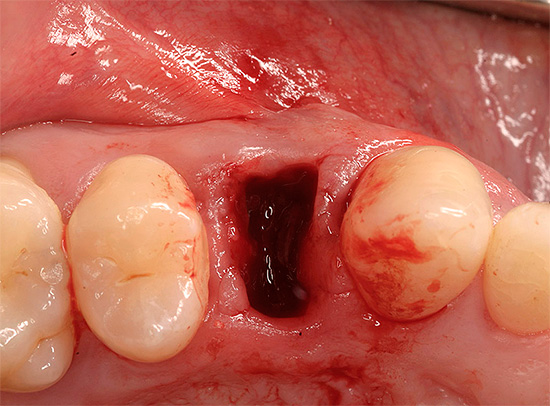
To rinse the oral cavity after tooth extraction, the dentist-surgeon can recommend using folk remedies (decoctions of chamomile, oak bark, sage, soda or saline solutions, etc.), and special pharmaceutical preparations (for example, chlorhexidine, furatsilin, miramistin and other).
This implements a very important (and, perhaps, the main) advantage of rinsing - pathogenic and conditionally pathogenic microorganisms are destroyed in the wound and oral cavity. Most often, it is opportunistic bacteria that are “waiting” for the situation when, against the background of a decrease in general or local immunity, they can harm a person, causing, for example, inflammation of the socket and suppuration of the hole after tooth extraction.
On a note
In addition to the influence of microbes accidentally introduced into a fresh hole during and after surgery, there are also a number of aggravating factors: almost every second case of tooth extraction is performed without preliminary sanitation of the oral cavity. In other words, around a fresh wound there are carious or even completely destroyed teeth (see the example in the photo below), plaque and stone can be present on the adjacent teeth. All this creates additional risks of inflammation of the hole, creating the prerequisites for the development of alveolitis.
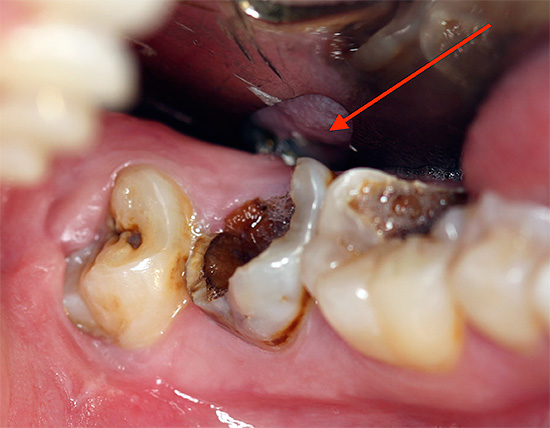
Thus, thanks to mouth rinses, it is possible to achieve a significant decrease in microbial activity in and around the wound, as well as improve the state of oral hygiene as a whole, even against the background of an unfavorable cariogenic situation and low level of tooth cleanliness. Rinse advocates focus on the possibility of creating an enabling environment for quick and painless healing of the gums - and this is a pretty weighty argument.
But opponents of any rinses, on the contrary, focus on a high percentage of risk of “rinsing” a protective blood clot from the hole, which almost always leads to alveolitis (inflammation of the tooth hole) and significantly reduces the healing rate of the gums.
Is there any way to find a middle ground between these two opposing approaches? Fortunately, yes, this can be done, and then we will not only consider how to put it into practice correctly, but also try to figure out what is better to rinse your mouth after tooth extraction in order to get the maximum positive effect and minimize the risks of complications and leaching of a blood clot from wounds.
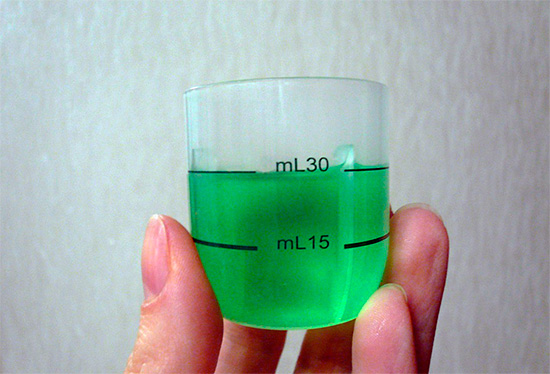
Dentist review
“The doctors of our hospital constantly advise rinsing the mouth with soda and salt after tooth extraction. I can’t understand where they were taught this, but after their appointments, patients often come with alveolitis.Is it really not clear that soda and salt with a normal rinse literally “tear off” a blood clot and create a favorable environment in an empty hole for the reproduction of bacteria. Soda-salt solutions are suitable for the maximum, like oral baths: held in the mouth - carefully spat out and that's it. No need to rinse! Why do we spoil our own lives - I do not understand ... "
Irina, Omsk
When is it best to rinse your mouth after tooth extraction, and how to do it right
Since the debate about the advisability of rinsing the mouth after tooth extraction has not yet subsided, a third opinion arose, so to speak, against the background of these confrontations. Having a little understanding of this new position of doctors, even an ordinary person without preparation will fully understand the answers to the following questions:
- When exactly can you start rinsing your mouth after tooth extraction (after how many hours) and how many days it should be done;
- The better it is to rinse your mouth to achieve a positive effect and at the same time avoid negative effects.
Let's first look at the first item in detail.
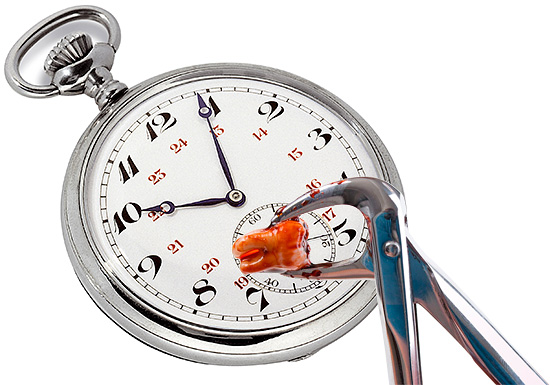
As soon as the dental surgeon completes his work and puts a sterile gauze swab on a bleeding wound, a blood clot begins to form in a fresh tooth hole. It is important to adhere to the following recommendations:
- within 2-3 hours after tooth extraction it is forbidden to eat and smoke;
- during the first day it is especially important not to pick a hole and try not to touch it with your tongue;
- to preserve a blood clot in the hole, it is impossible in the first few days after tooth extraction to steam in the bath, to overheat, to engage in heavy physical labor;
- it is not recommended to sleep with that side of the face down where the tooth was removed.
Is it possible to rinse your mouth on the first day after tooth extraction? According to studies, any rinsing during this period of formation of a blood clot is a direct risk of its violation and leaching. In this case, the so-called effect of a dry hole often occurs and subsequently its suppuration.
However, no one forbids conducting antiseptic oral baths according to the principle: "scored in the mouth - and spat out." Oral baths are good in that they have practically no restrictions on the frequency of the procedure (within reasonable limits), so they can be carried out not only after eating, but also in the spaces between them - at least 5-6 times a day, depending on which rinse means.
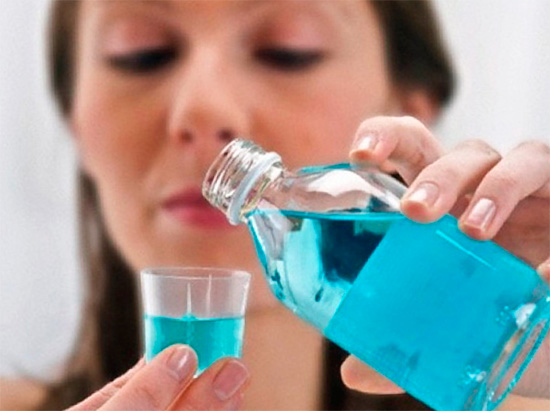
Feedback:
“... My girls, you can’t rinse your mouth with anything at all, otherwise the clot will fly off your gums and you won’t stick it back! About a year ago, I had a difficult extraction of a wisdom tooth when even stitches were applied. The doctor strictly forbade me to rinse anything, but recommended oral baths with Romazulan. That is, do not gurgle in your mouth, but just hold it there for 10 seconds and spit it out.
My friend told me that she managed to start rinsing already 4 hours after tooth extraction. To do this, she prepared herself almost a hot solution of soda and salt. As she told me, this is so that the microbes dissolve faster. But in the end, she suffered on the first day with bleeding from the gums, and then a few more days with severe pain, until she went to the doctor. And that was her brains and set for self-medication. Therefore, girls whose hands itch to soda and salt, immediately remember the sad experience of my girlfriend. "
Eugene, Saratov
Now let's see how you can make oral baths after tooth extraction (or rinse your mouth very carefully - a few days after the procedure) and what “pitfalls” you should know in advance when choosing this or that remedy.
Drugs used to rinse the mouth after tooth extraction
To understand what is better to rinse your mouth after tooth extraction (hereinafter, this formulation should also be understood as oral baths), we will try to evaluate the properties of the most commonly prescribed dental surgeons. The most popular of them:
- Chlorhexidine;
- Furatsilin;
- Potassium permanganate;
- Miramistin;
- Decoctions of herbs (doctors can also prescribe them, despite the fact that this is, in general, traditional medicine).
How to rinse with chlorhexidine and preparations based on it
Chlorhexidine is an effective antiseptic with high antimicrobial activity against gram-positive and gram-negative bacteria, protozoa, and also some viruses. As rinses, 0.05-0.1% aqueous solutions of chlorhexidine (usually in the form of a bigluconate) can be used.
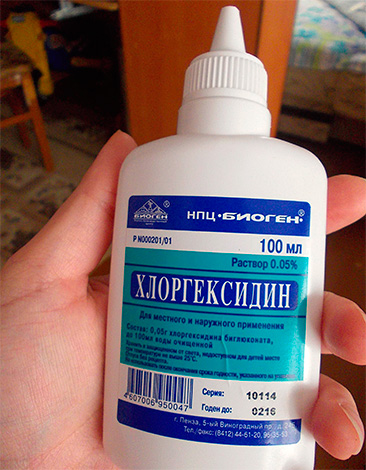
As usual, rinse your mouth with chlorhexidine after tooth extraction:
- At first, it is recommended to rinse the oral cavity with ordinary warm boiled water (however, now you know that this insidious recommendation without additional explanations can easily lead to the washing out of a blood clot; therefore, do not rinse it actively! They typed into your mouth and neatly spat);
- Then you should take 10-15 ml of chlorhexidine solution in the mouth and make the solution move in the oral cavity for 20-30 seconds, repeating the procedure 1-2 times (again, it is better to do without the active movements of the solution, that is, without "gurgling"; just make a bath). As a rule, 2-3 rinses per day are sufficient.
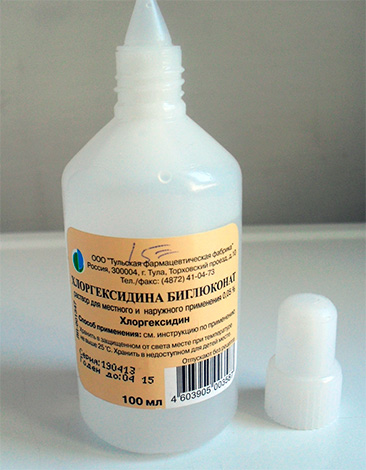
It's important to know!
If a burning sensation appears in the mouth during rinsing, this means that a too high concentration of the solution is selected. It is necessary to immediately fill in the mouth with warm, clean water and remove the remaining product as soon as possible. The recommended safe concentration of solutions for oral baths and rinses is not more than 0.5%, and better generally 0.1% (higher concentrations are also on sale, so be careful). When preparing the solution yourself, it is important to strictly observe the dilution scheme.
Chlorhexidine preparations may have other names. For example, Corsodil is the same aqueous solution of chlorhexidine, but it costs significantly more due to imported origin. The price difference is significant, but the result is the same.
We should not forget about contraindications: for children (especially young children) chlorhexidine and its analogues are not recommended for use, or are used with extreme caution. And why rinse your mouth with chlorhexidine after removing a tooth from a small child, because the crumbs can accidentally swallow the solution. In addition, chlorhexidine should be used with special care by pregnant and lactating women, as well as with individual intolerance to the substance.
Can furatsilin be used after tooth extraction to heal faster?
In Soviet times, rinsing with furatsilin was very popular in dentistry and otorhinolaryngology (and not without reason). They could not think of a better way to fight the infection than rinsing the mouth with furatsilin after removing the tooth with pus.
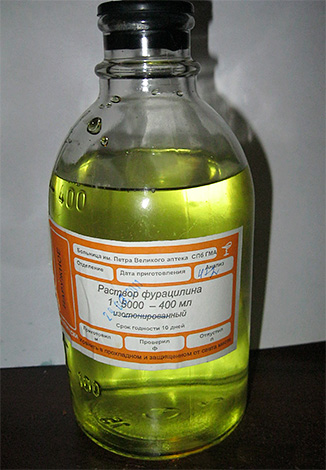
When doctors realized that the appointment of intensive rinses (especially on the first day after tooth extraction) negatively affects the blood clot and its safety, a more progressive option was proposed - oral baths with furatsilin solution. The principle is as follows:
- Take the finished aqueous solution (not alcohol!) In bottles (0.02%), or dilute 10 tablets of furatsilin (0.01 grams each), or 5 tablets (0.02 grams each) in a liter of water;
- Keep in your mouth for 1-2 minutes 3-4 times a day (do not rinse).
It is interesting
Furacilin is a relatively weak antiseptic (especially, so to speak, in modern purulent surgery), and the resistance of many microorganisms to its action has been proved. Furatsilin often dries out the mucosa, has an extremely unpleasant bitter aftertaste that is remembered for a lifetime.
Unfortunately, it is not always possible to find ready-made bottles with diluted furatsilin, but tablets are available at any pharmacy. Diluting 10 tablets per liter is impractical, since usually a small amount of solution is required. Here the most interesting begins, popularly called "by eye". And the result of such experiments often become irritations of the oral mucosa.
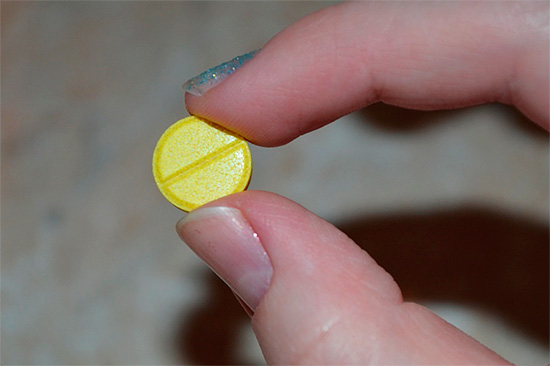
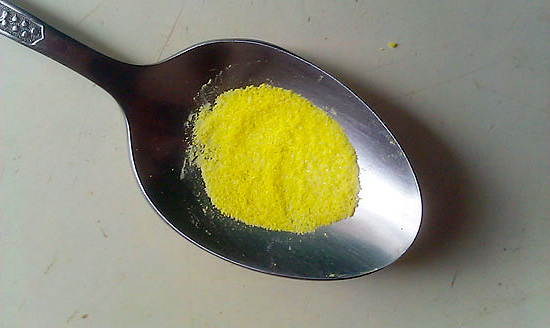
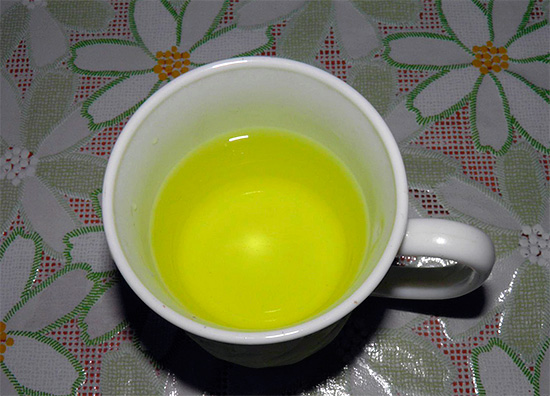
About mouthwash Miramistin
Miramistin, despite some similarity in principle to chlorhexidine preparations, has a wider spectrum of action against bacterial, fungal and viral infections. Besides the fact that he actively fights against various pathogenic bacteria, fungi and viruses that may be in the oral cavity and interfere with the normal healing of the socket, its safety for humans has been proven even with repeated use.
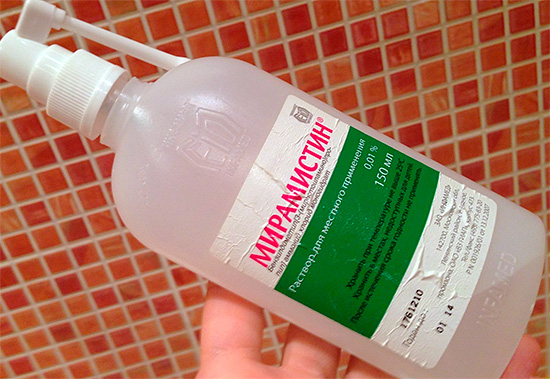
It is interesting
The development of Miramistin began in the 70s of the last century for astronautics. The scientists were given the task: to find such an antiseptic that will be absolutely safe for humans, but very active against bacteria, fungi and viruses. It was planned to use it to disinfect the skin of astronauts and a number of instruments at the station. However, after the collapse of the USSR, research funding ceased, and only a group of enthusiastic scientists continued to search for such a drug. Only in 1991 did Miramistin appear, which, unlike its relative, chlorhexidine, had a wider spectrum of action and high antimicrobial activity, and was also safe for children, pregnant and lactating mothers.
So, imagine: a tooth was pulled out for you, and you were going to rinse your mouth with Miramistin. The concentration of its solutions that you will find on sale is always the same - 0.01%, and this is quite enough. For dentistry needs, bottles with spray nozzles are convenient, although, for example, in ENT practice, Miramistin solutions in bottles without such nozzles are used (for rinsing the throat and tonsils).
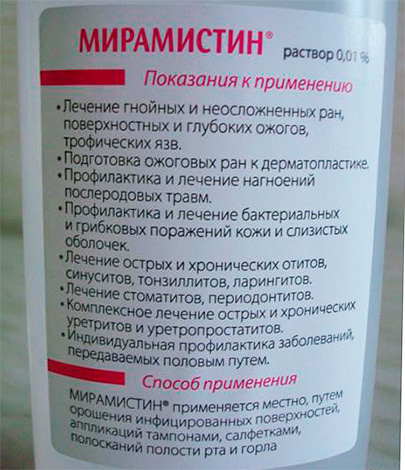
When buying in a pharmacy, it is useful to warn the pharmacist for what purpose the product is being purchased, otherwise embarrassment may come out: you will have to adapt the applicator for the urethra to the oral cavity, since Miramistin with a urological nozzle is also on sale.
To disinfect the wound, it is enough to spray Miramistin solution 1-2 times in the direction of the hole of the extracted tooth, holding the sprayer no closer than 5 cm from the hole - so as not to damage the blood clot with the jet. Then you do not need to wash off the sprayed antiseptic with water, that is, sprayed it - and forgot. The procedure can be repeated 2-3 times a day for 5-6 days.
Gargling with potassium permanganate solution
To prepare the “correct” 0.1% solution of potassium permanganate, you will need 1 gram of potassium permanganate powder and 1 liter of warm water. The solution should be slightly pink.
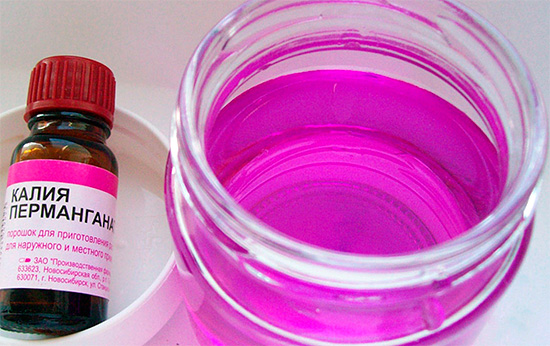
In the practice of Soviet-era dentists, there were cases of mucosal burns due to improper dilution of the drug at home, which is why for a number of other reasons it is better to rinse the gums after tooth extraction with something else rather than a potassium permanganate solution. In addition, keep in mind that if individual crystals of permanganate have not yet dissolved, then rinsing the mouth with such a solution can also cause burns, even if initially the ratio of powder and water was taken correctly.
It is interesting
In order to dilute potassium permanganate, you must first purchase it in a prescription pharmacy according to a strict doctor's prescription. In 2007, by decree of the Government of the Russian Federation, potassium permanganate was excluded from free sale.
Can I rinse my mouth with vodka or alcohol?
It may seem that in order to disinfect it is quite acceptable to rinse the wound after tooth extraction with alcohol or vodka. Ethyl alcohol is an excellent antiseptic.
However, dentists are categorically against the use of alcohol solutions for rinsing the mouth.
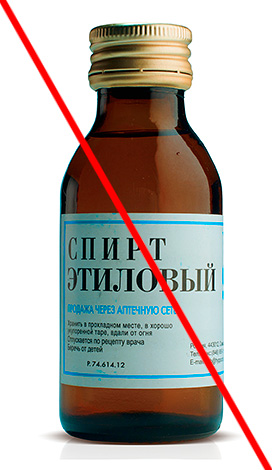
The reasons are as follows:
- Alcohol in general is a common cause of repeated bleeding from the hole due to the separation of the formed crust of a blood clot and the expansion of blood vessels;
- Alcohol is irritating to the oral mucosa, so the process gum healing after tooth extraction slows down;
- Vodka and alcohol can cause severe pain when it hits an open wound.
So no rinsing with alcohol and vodka, including it will be useful to refrain from taking strong drinks inside for at least a few days.
Is it possible to smear the gums after tooth extraction with “green” or iodine?
Generally speaking, if you choose the lesser of two evils, it would be safer to treat the gum after you have your tooth pulled out with a 1% alcohol solution of brilliant green (“green”), in contrast to a 5% alcohol solution of iodine. Treatment of the oral mucosa with such iodine concentrations often causes serious burns, leading to erosion and ulcers.
But even though the “green” is less likely to harm the oral mucosa than the pharmacy iodine solution, however, from the point of view of logic and common sense, it is not worthwhile to smear the gums after tooth extraction with “green” on the first day or in the following days. Firstly, it hurts (remember the effects of alcohol on wounds). Secondly, it is unsafe for the normal healing of the gums due to its drying by such active antiseptics. Thirdly, when trying to spread “green stuff” on a wound, it is easy to damage a blood clot.
In general, neither zelenka nor iodine are highly recommended for treating a well after a tooth extraction procedure.
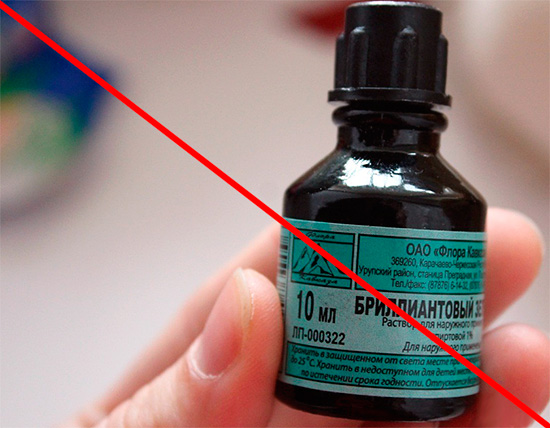
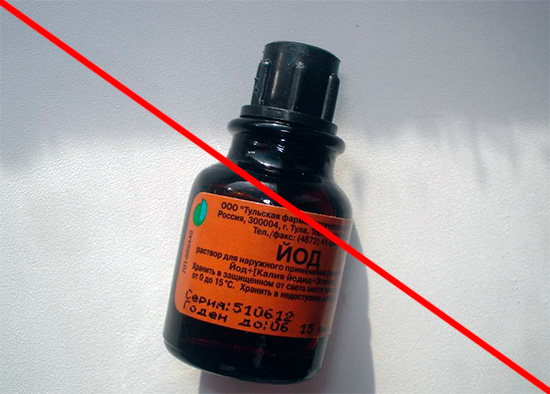
Feedback
“My friend is constantly smearing something in her mouth with green stuff. Just a little sore in the mouth - immediately green, and recently removed the tooth and let's burn yourself there to stupor. No, well, I understand everything, bacteria and all that: sort of anointed and killed them, but why in such a barbaric way? After all, it’s full of all kinds of pharmacy products that don’t burn the mouth, but they kill bacteria the only way. ”
Alexandra, Moscow
The harm and benefits of hydrogen peroxide as a means to rinse the mouth after tooth extraction
Pharmacy 3% hydrogen peroxide is a very powerful antiseptic, which decomposes in the course of its work into oxygen and water. By the way, dental surgeons also use the property of hydrogen peroxide to stop capillary bleeding after tooth extraction: in this case, make contact 3% hydrogen peroxide on a gauze swab directly with the wound surface.
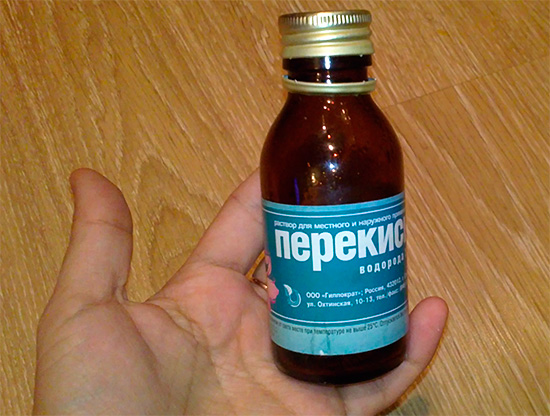
However, with all these positive properties, rinsing the mouth with hydrogen peroxide after tooth extraction can do more harm than good, so you should not practice this method of disinfection of the hole at home. The main problem is that when the solution comes into contact with the mucous membranes (especially with the wound surface), active foaming occurs with the release of oxygen bubbles. In some cases, this can lead to mechanical damage to the blood clot by expanding gas bubbles.
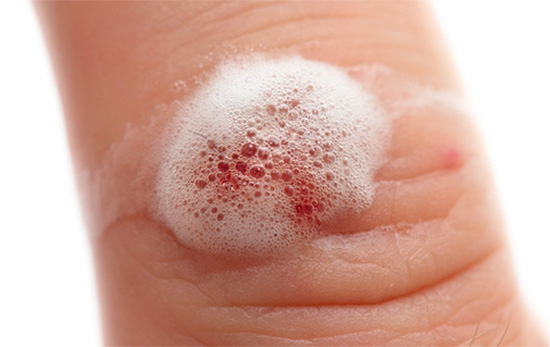
In addition, a 3% concentration of hydrogen peroxide is ideal only for local treatment, but with oral baths and rinses, irritation of the oral mucosa can occur.
Herbal preparations for quick healing of gums
Among the pharmacy herbal anti-inflammatory drugs, the following are very popular:
- Chlorophyllipt;
- Salvin;
- Stomatophyte.
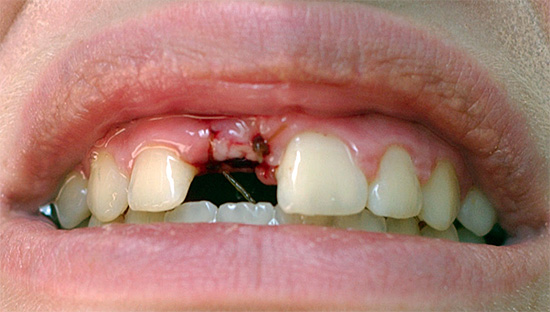
However, if someone recommends you to use these rinses after tooth extraction, it is useful to take into account some nuances first.
Chlorophyllipt is a drug derived from eucalyptus leaves. It has a moderate antibacterial activity and to some extent (generally slightly) stimulates wound healing.It is used as an alcohol tincture for disinfecting wounds - we have already talked about the negative effect of alcohol-containing solutions.
Salvin is also an alcohol-containing preparation containing essential oils and tannins. It has anti-inflammatory and antimicrobial effects. Before use, a 1% alcohol solution is diluted, diluted with water to low concentrations (about 5-10 times), and used for applications, irrigation and lubrication. As you know, in this form, the alcohol concentration is already significantly reduced. In the best case, Salvin can be used locally for irrigation of the hole after tooth extraction (oral baths), however, if pain and irritation appear, such treatment should be immediately abandoned.
Stomatophyte is a herbal preparation based on an extract of herbs that has anti-inflammatory effect. For dilution of the drug with water, there are special dosimeters and measuring devices (diluted to a 15% concentration). It does not irritate the oral mucosa, therefore, in the first days after tooth extraction is quite suitable for oral baths.
Special mouthwash
Many mouthwashes for home use, in addition to antibacterial activity, also have a pronounced anti-inflammatory effect. For example, this includes a group of home oral hygiene products aimed at reducing the inflammatory response in damaged gums - based on azulene, chlorophyll, coniferous extract, St. John's wort, sage, oak bark, etc.
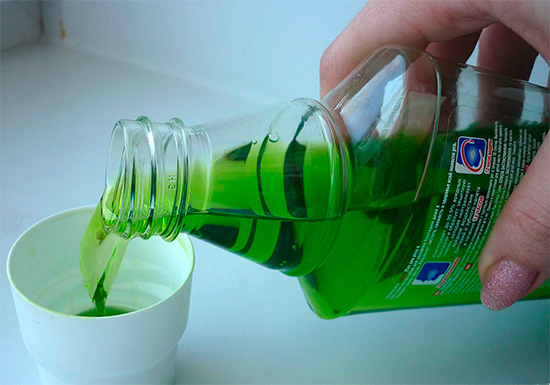
Careful use of such rinses as a means for oral baths is perfectly acceptable.
Feedback
“In principle, I did not use rinsers until one day I got a wisdom tooth pulled out. It was a test such that you do not wish the enemy. Not only that, they pulled out a tooth for more than an hour, so on the third day the pain in the gums started, and the smell from my mouth went away, it was a shame to go to work. Just near the washstand was a rinsing agent Forest Gum Balm, which had not been used by the wife for more than a year. A couple of times in the morning I rinsed them, felt better, the pain subsided slightly, it became easier to communicate with people. In the evening I held the balm in my mouth for a little while, and in the morning my gums almost did not ache ... ”
Valery, St. Petersburg
Folk rinses: advantages and disadvantages
Among the popular methods and means for home mouth rinses, two positions are in the lead:
- Soda-salt solutions;
- Decoctions of herbs.
The first category is by far the most, perhaps, controversial. Many dentists categorically do not accept any soda and salt rinses (as well as combinations) rinsing neither the first nor the next days after tooth extraction, since this is due to the irritating effect of the solution on the wound and the destructive effect of the components of the solution on the blood clot.
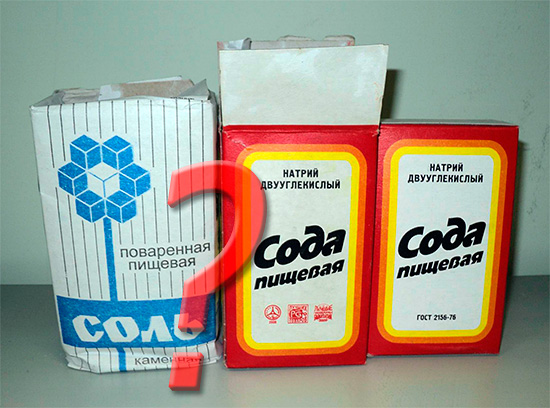
On a note
The so-called “old guard” of dentists still does not recognize other solutions than simply appointing a patient to rinse the mouth with soda or saline (especially after tooth extraction with pus). Often there is a combination of soda and salt to achieve the greatest effect. The task of such rinses is to “draw” pus from the wound with a hypertonic solution, although many dentists are against this approach, considering it unscientific and too risky for the integrity of a blood clot.
In general, we can say this: if there are big risks to harm a blood clot, even with all the antiseptic and hygienic advantages of soda, in a modern civilized society, it is better to prefer another option for caring for a hole in an extracted tooth.
Now a few words about decoctions of herbs. Most dentists who advocate the most gentle rinsing choose herbal decoctions for rinsing the mouth after tooth extraction: the oral bath technique in the first few days after the procedure is considered optimal.For this, you can use, for example, decoctions of chamomile or sage.

Recall that oral baths allow for antiseptic irrigation of the healing wound without harm to the clot, since the option of "gurgling" in the mouth is excluded. In practice, the principle “scored a solution in the mouth and spat out” is very effective for repeated use during the day.
A small summary
So why is it better to rinse your mouth after tooth extraction, so that the healing of the gums goes quickly and without problems?
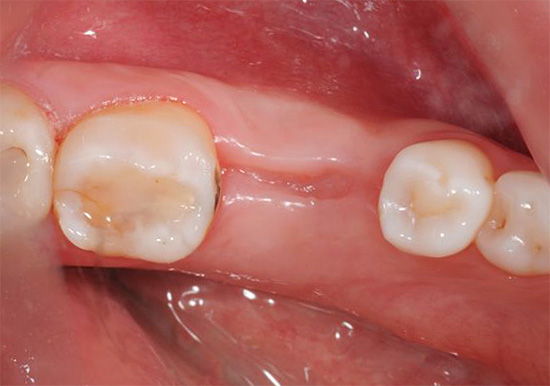
Well, the main options are as follows:
- Do not rinse anything;
- Rinse with what the doctor recommended;
- Or confine yourself to the mouth baths of mildly acting antiseptics (listed above).
Very many, including highly professional, experts are of the opinion that it is generally worthless to rinse the oral cavity after the tooth extraction procedure, but at the same time they emphasize the quality of the removal. In other words, the more professionally performed tooth extraction with minimal loss of tissue surrounding the well, the faster the wound will heal. In this case, regular rinsing by any means will only interfere with the normal healing of the hole.
At the same time, it is not recommended to apply any ointments or gels to the healing wound. All that is formed in a perfectly formed hole after tooth extraction is a blood clot, which, when following recommendations for protecting it from damage, does not need to be rinsed, being the best natural barrier to protect microbes and their toxins from penetrating deep into the hole.
If the doctor nevertheless prescribed rinses for you, then in a particular clinical case this is most often quite justified. The most important thing here is not to self-medicate, and at the first signs of alveolitis (inflammation of the hole), you should consult your doctor. If you are confident in your dentist, then listen to him, and wound healing will go without complications.
If in doubt in the competence of the doctor, you can get advice from 1-2 specialists at once and draw conclusions. Fortunately, in most cases, such consultations are provided absolutely free today.
Interesting video: what is important to know about the healing of the hole after tooth extraction
On the appearance of pain some time after tooth extraction (alveolitis)

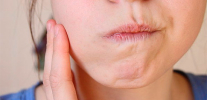
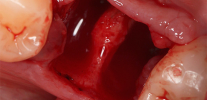
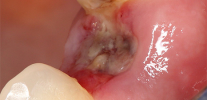
The article is excellent, but I understood that it’s better not to rinse it yet 🙂
Yes, it’s better not to rinse, but if you want to play it safe, you can use periodontal gel to smear the gums. But the gel will help to avoid inflammation and help to heal the gums faster. I have already used this method 2 times (torn out 2 wisdom teeth 🙁), it always helped perfectly. And rinsing can begin later, when the wounds begin to heal.
Sage helps well.
It is said that you can not lay the ointment. What kind of people are these ...
Sage - yes! It is necessary to hold in your mouth, after 6 hours, and rinse after each meal 4-6 days.As my dentist recommended.
After tooth extraction, the gum swelled. How to rinse?
Hello! Without the appointment of a dentist, it is better not to rinse anything. It is advisable to find out why the gum is swollen (swelling due to trauma or a beginning complication?). The scheme is as follows: determining the cause of the problem at the doctor - then correction of treatment - then prescribing. If the opposite is done, then it can lead to serious problems and, in general terms, do harm (rinse with a protective blood clot, there will be a dry hole, alveolitis, etc.). Be treated correctly. Health to you!
And after the tooth extraction, the doctor left me a tampon in the hole. The gums hurt. I asked my husband - he pulled out a swab with tweezers. At first it became easier, then the pain intensified. I went again to the doctor, and she told me: why were they pulled out? I say: this is a foreign object, it interferes with healing. And she: there is medicine, and as it heals, the tampon itself will come out. As long as I live in the world, I have already removed half my teeth - this is the first time I've heard. Is this a new trend in medicine? She asked to be removed completely (suddenly something else remains), and she told me: how will you eat? I say: I will starve. I won’t die in 2-3 days. She shrugged, fiddled, and advised baths with salt and soda. Now the gum hurts less, but I try not to rinse anything ... I wait, I hope for Allah ...
Hello! On the one hand, many dentists would agree with you - those who try not to use medicinal tampons for the prevention and treatment of alveolitis (tampons for some time either fall out of the hole or dissolve as it heals). This is due to the fact that this treatment is not suitable for all people + allergic reactions occur in a number of patients to iodine-containing compounds. On the other hand, such methods will not leave the dental market for a long time, as they are actively used by another part of the doctors, and in many ways not bad.
It’s good that your symptoms are decreasing every day. About rinsing - this is a separate issue, but the fact that you do not rinse with soda and salt is already good (so as not to irritate the wound again and not interfere with the process of its normal healing).
Removed the root of the tooth, pain appeared, swollen cheek. It's the fifth day. I’m taking antibiotics - the tumor has passed a little, but the pain has not decreased. I drink constantly antibiotics. Since I’ll see a doctor only tomorrow, I don’t know what to do to take painkillers less. Could this pain be due to the fact that there were numerous cysts on the root of the tooth?
Hello! Count on painkillers, of course, is not worth it. Most likely, a curettage of the hole will be required (the need for this procedure should be assessed by the dentist surgeon after the examination). Almost always, it brings significant benefits. It is only advisable to pre-take a picture of the hole to clarify whether there are any fragments of tooth in the hole, pieces of bone tissue, etc. Any “garbage” interferes with the normal course of healing of the hole, often causing swelling and pain.
As for the last question: if there were cysts on the root of the tooth, then during removal there could be a partial detachment, and they remain in the hole. It is in this context that curettage is important for scraping all the “dirt” from the wound.
Good evening, they removed the wisdom tooth at the 18th week of pregnancy, they said nothing to rinse. After 20 minutes, removed the swab, as they said. When anesthesia began to recede, she died, drank citramone, and he relieved aching pain. But today is already 4 days, I began to rinse with chlorhexidine and chamomile, the tooth aches, I do not know what to do! Desna hurts too! Should I be worried?
Hello! I think that rinsing in this case is not entirely appropriate when it comes to starting alveolitis - inflammation of the dimples. It is recommended that you consult your doctor so that you can get an opinion on the condition of the hole at the healing stage. In the case of a diagnosis of alveolitis, the doctor will definitely carry out a treatment correction: curettage of the hole with anesthesia with the appointment of antibacterial agents and anti-inflammatory drugs.
Therefore, the self-medication you started should prefer the opinion of the dentist.
If the jawbone peeks, can you somehow heal at home?
Hello! Correction of the alveolar wall is necessary at the dentist-surgeon or maxillofacial surgeon, as problems with restoration of the gingival margin can be observed. Sometimes the process of gum restoration is normalized without intervention, but in the conditions described by you it will be long, painful and with a risk of complications. As long as the bone tissue itself resolves, it can take up to 5-6 months after tooth extraction. Therefore, the sooner the problem is fixed, the easier it will be to live.
Hello. They removed 31 teeth, as I was told, it was difficult to remove, in parts they pulled out, with pus inside. It was unpleasant, but bearable. They said not to rinse your mouth, do not smoke or eat after removal. In general, he came, slept for a few hours, woke up - the anesthesia was already gone and the gums started to hurt. I drank pain medication (Nimesil powder), now it has become better, the pain has subsided!
I myself began to search the Internet on this subject and learned a lot of things for myself. In general, I know that you can’t eat solid foods, only soft and liquid foods are recommended. First broth and eggs diluted with milk. I ate, now I don’t know what to do - food got into the hole. How to take oral baths without damaging a blood clot in a hole ?!
Is it possible to take oral baths with Forest Balsam after taking liquid and soft foods?
Hello! Mouth baths are just safe for the clot, because they are used on the principle of “scored in the mouth, then carefully spat out”. But rinsing can harm the clot, so in the first days after tooth extraction it is better to refrain from them. As for Forest Balsam, I am sure that there will be no harm from its use.
Maraslavin is an excellent remedy.